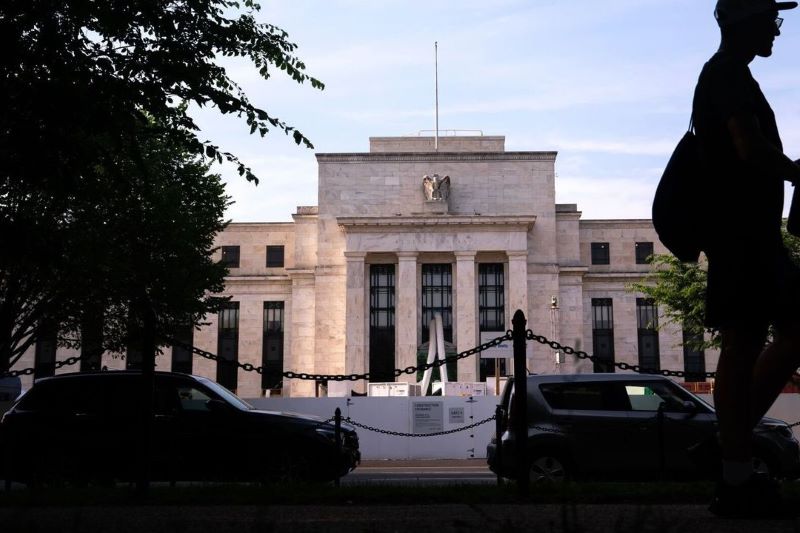Economy
Fed Stands Alone: Defers Rate Cuts Amid Global Easing Trend
In a rare and notable departure from the prevailing consensus, the Federal Reserve stands apart, finding itself in a divergent position from many of its counterparts across the globe. This distinct stance taken by the Federal Reserve reflects a nuanced approach that acknowledges unique domestic economic conditions while also navigating the intricate web of interconnected global financial dynamics.
Global Easing Trend: Central Banks Lower Rates Amid Economic Uncertainty
Come Wednesday, it appears the stage is set for yet another disappointment for investors as the eagerly awaited initial reductions in interest rates, since the emergence of the Covid-19 pandemic, are likely to be postponed once again.
Investors face recurring disappointment as anticipated interest rate cuts post-Covid are likely postponed, WSJ Print Subscription said.
ECB, BoC, Sweden, and Switzerland Act: Why is the Fed Holding Back?
This unfolds against a backdrop where several major central banks have already embarked on rate cuts. Just last Thursday, the European Central Bank became the most recent entrant to embark on easing policy, lowering its benchmark rate by a quarter point. Preceding this move, the Bank of Canada had taken a similar step the day prior. Earlier this year, Sweden and Switzerland had also taken the plunge.
Perplexing ECB Move: Understanding the Reasons Behind Divergence
Interestingly, the circumstances in these countries don’t markedly diverge from those in the U.S., particularly from a monetary policy standpoint. Across Europe and North America, inflation has significantly decelerated, and economic growth has exhibited signs of resilience. So, what accounts for the divergent actions, with others easing while the Federal Reserve maintains its stance?
ECB’s Nuanced Decision: Confidence in Inflation Trajectory
The ECB’s recent decision is somewhat perplexing. It arrived just days after data revealed an uptick in the inflation rate to 2.6% in May from 2.4%. Concurrently lowering rates, the ECB also upwardly revised its forecasts for economic growth and inflation. It rationalized this action by expressing increased confidence in the long-term trajectory of inflation.
Canada’s Unique Circumstance: Balancing Debt and Inflation
Higher rates affected Canada more due to elevated debt levels and greater dependence on the housing market for growth. However, the backdrop differed slightly as the inflation rate stayed within the bank’s target range for four consecutive months.

Home Buyers Struggle with Rising Prices and Mortgage Rates
Home buyers are facing an increasingly difficult market as both home prices and mortgage rates climb, making it hard to find relief…
Currency Concerns Drive Sweden and Switzerland: A Preemptive Move
The decisions of Sweden and Switzerland may have been influenced as much by currency concerns as by other factors. Anticipating the trajectory of events in the eurozone and the U.S., they sought to preemptively act to prevent their currencies from strengthening excessively. Strong currencies can undermine exports, which are particularly vital for growth in open economies such as Switzerland and Sweden.
Fed’s Caution: Lack of Confidence in Inflation Trajectory
So, what sets the Federal Reserve apart? One notable factor is the apparent lack of confidence, compared to its counterparts, particularly regarding the trajectory of inflation. While inflation had been steadily declining until late last year, it has since remained above 3%.
Fed’s Stance: Confidence in U.S. Economy
Moreover, from the Fed’s perspective, there are fewer concerns about the state of the economy. The U.S. continues to generate ample employment opportunities, as evidenced by Friday’s nonfarm payrolls report. While growth is anticipated to moderate this year, the U.S. appears robust enough to avoid a significant uptick in unemployment — a scenario often associated with slowing inflation, known as the Goldilocks scenario or a soft landing.
ING Economists’ Insights: Fed Likely to Proceed with Caution
ING economists, headed by James Knightly, suggest Federal Reserve policymakers will likely avoid needlessly causing a recession. They may cautiously adjust monetary policy, albeit to a limited extent, if data allows.
BOE to Follow Suit: Delayed Rate Cuts Expected
The Fed’s stance of caution is not unique. The Bank of England, scheduled to announce its next policy decision next week, is also anticipated to delay interest rate cuts until later in the year. While U.K. growth hasn’t mirrored the vigor seen in the U.S., inflation has demonstrated a similar stubbornness. Despite a decline to 2.3% in April from 3.2% in March, the BOE expects inflation to rebound as the impact of lower energy prices dissipates, hence holding off on rate cuts for now.
Historical Alignment: Interconnected Monetary Policies
Americans find comfort in the historical alignment of monetary policies in Europe and North America for three decades. Despite differences, they interconnect through open trade and common central banks controlling inflation.
Anticipating Fed’s Move: Rate Cuts on the Horizon, but Not Imminent
Ultimately, while there are discernible distinctions among these economies, Americans can reasonably anticipate rate cuts from the Fed — it’s just not an imminent development yet.
Unlock unparalleled financial expertise with an extraordinary 77% off a joint Washington Post and Barron’s Digital Subscription, priced at only $199. Delve into current market dynamics, gain invaluable stock perspectives, and stay ahead with comprehensive financial insights. Perfect for both seasoned investors and newcomers alike.

